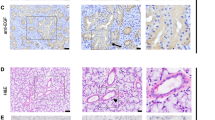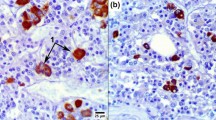Summary
The proliferative response to isoprenaline in the submaxillary and parotid glands of the Balb/c mouse has been studied in the intact male and female, and also in the male castrated one month prior to stimulation. The hyperplastic response of the acinar cells has been monitored by serial measurements of the flash tritiated thymidine labelling index and the mitotic index. Castration caused the atrophy of the granular ducts in the submaxillary gland, and therefore an increased predominance of the acini. At one month after castration the acini occupied an area almost 1.5-fold greater than that of the granular ducts, but this was not as great as in the intact female gland where acini occupied twice the area of the granular ducts. Hyperplasia was induced by a single injection of isoprenaline (0.3 mM/kg body weight). The response of the submaxillary gland in the intact male and intact female was very similar, DNA synthesis commencing 21–24 h after stimulation and mitotic activity first noted after 33–36 h. On the other hand, in the submaxillary gland of the castrated male, DNA synthesis began after only 18–21 h and mitotic activity after only 27–30 h. A metaphase arrest experiment with vincristine confirmed the more prompt response in the castrated animals; between 33–36 h after isoprenaline injection, the rate of entry of cells into mitosis was 4 cells/100 cells/h in the castrated group but only 0.4 cells/100 cells/h in the intact males. Thus castration appears to bestow a unique state of responsiveness upon the submaxillary gland to isoprenaline stimulation. The mechanisms underlying this change are not yet understood, for it is paradoxical that atrophy of a structural component rich in specific protein growth factors can alter the format of isoprenaline-induced hyperplasia in acinar cells that produce secretory glycoproteins.
Similar content being viewed by others
References
Aumuller G, Giers K, Giers U, Volkl A, Seitz J (1981) p-Chlorophenylalanine-induced proliferation of the seminal vesicle epithelium. Cell Tissue Res 219:159–172
Barka T (1967) Stimulation of deoxyribonucleic acid synthesis in the salivary gland by isopro- terenol. The effect of sex. Exp Cell Res 48:53–60
Barthe PL, Bullock LP, Mowszowicz I, Bardin CW, Orth DN (1974) Submaxillary gland epidermal growth factor: a sensitive index of biologic androgen activity. Endocrinology 95:1019–1025
Burton K (1968) Determination of DNA concentration with diphenylamine. In: Grossman L, Moldave K (eds) Methods in enzymology, vol 12B. Academic Press, New York, pp 163–166
Caramia F (1966) Ultrastructure of mouse submaxillary gland. II. Effect of castration in the male. J Ultrastruct Res 16:524–536
Chesters JK (1975) Comparison of the effects of zinc deprivation and actinomycin D on ribonucleic acid synthesis by stimulated lymphocytes. Biochem J 150:211–218
Choie DS, Richter GW (1972) Cell proliferation in rat kidney induced by lead acetate and effects of uninephrectomy on the proliferation. Am J Pathol 66:265–275
Chretien M (1977) Action of testosterone on the differentiation and secretory activity of a target organ: the submaxillary gland of the mouse. Int Rev Cytol 50:333–396
Fabrikant J I (1968) The kinetics of cellular proliferation in regenerating liver. J Cell Biol 36:551–565
Gelfant S (1981) Cycling ai noncycling cell transitions in tissue aging, immunological surveillance, transformation and tumour growth. Int Rev Cytol 70:1–25
Gresik EW, MacRae EK (1975) The postnatal development of the sexually dimorphic duct system and of amylase activity in the submandibular glands of mice. Cell Tissue Res 157:411–422
Hall HD, Schneyer CA (1964) Salivary gland atrophy in rat induced by liquid diet. Proc Soc Exp Biol Med 117:789–793
Hall HD, Schneyer CA (1977) Functional mediation of compensatory enlargement of the parotid gland. Cell Tissue Res 184:249–254
Koschel KW, Hodgson GS, Radley JM (1976) Characteristics of the isoprenaline stimulated proliferative response of rat submaxillary gland. Cell Tissue Kinet 9:157–165
Morley AR, Wright NA, Appleton DR (1973) Cell proliferation in the castrate mouse seminal vesicle in response to testosterone propionate. I. Experimental observations. Cell Tissue Kinet 6:239–246
Novi AM, Baserga R (1971) Association of hypertrophy and DNA synthesis in mouse salivary glands after chronic administration of isoproterenol. Am J Pathol 62:295–308
Pinkstaff CA (1980) The cytology of salivary glands. Int Rev Cytol 63:141–261
Schneyer CA, Hall HD (1975) Parasympathetic regulation of mitosis induced in rat parotid by dietary change. Am J Physiol 229:1614–1617
Srinivasan R, Chang WWL (1979) The postnatal development of the submandibular gland of the mouse. Cell Tissue Res 198:363–371
Tom-Moy M, Barka T (1981) Epidermal growth factor in the submandibular glands of inbred mice. Am J Anat 160:267–276
Turkington RW, Males J L, Cohen S (1971) Synthesis and storage of epithelial-epidermal growth factor in submaxillary gland. Cancer Res 31:252–256
Van Noorden S, Heitz P, Kasper M, Pearse AGE (1977) Mouse epidermal growth factor: light and electron microscopical localisation by immunocytochemical staining. Histochemistry 52:329–340
Weinbren K, Stirling GA, Washington SLA (1972) The development of a proliferative response in liver parenchyma deprived of portal blood flow. Br J Exp Pathol 53:54–58
Wright NA, Alison MR (1984) The biology of epithelial cell populations, vol 2. Oxford University Press, Oxford [in press]
Wright NA, Appleton DR (1980) The metaphase arrest technique. A critical review. Cell Tissue Kinet 13:643–663
Author information
Authors and Affiliations
Rights and permissions
About this article
Cite this article
Hully, J.R., Benton, H.P. & Alison, M.R. Isoprenaline-induced cell proliferation in mouse salivary glands: the effect of castration. Virchows Archiv B Cell Pathol 47, 95–105 (1984). https://doi.org/10.1007/BF02890192
Received:
Accepted:
Issue Date:
DOI: https://doi.org/10.1007/BF02890192




